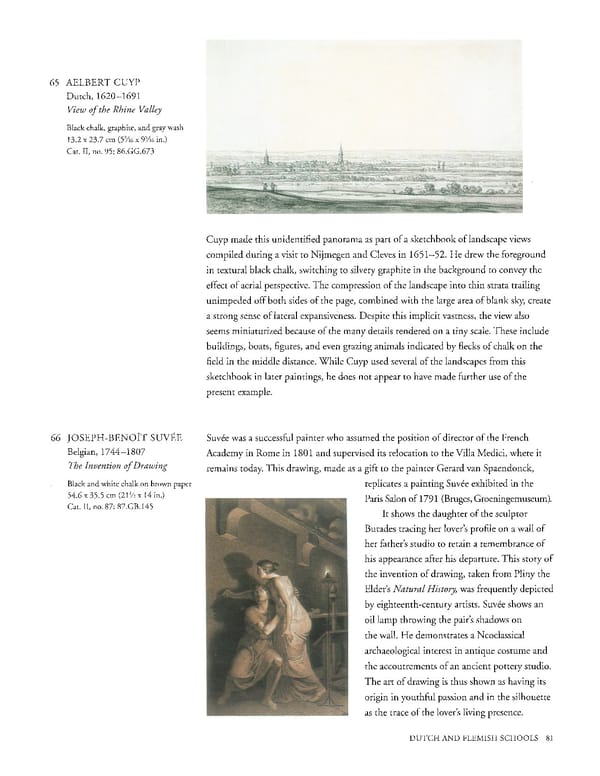65 AELBERT CUYP Dutch, 16201691 View of the Rhine Valley Black chalk, graphite, and gray wash 13.2 x 23.7 cm (5 3/16 x 9 5/16 in.) Cat. II, no. 95; 86.GG.673 Cuyp made this unidentified panorama as part of a sketchbook of landscape views compiled during a visit to Nijmegen and Cleves in 165152. He drew the foreground in textural black chalk, switching to silvery graphite in the background to convey the effect of aerial perspective. The compression of the landscape into thin strata trailing unimpeded off both sides of the page, combined with the large area of blank sky, create a strong sense of lateral expansiveness. Despite this implicit vastness, the view also seems miniaturized because of the many details rendered on a tiny scale. These include buildings, boats, figures, and even grazing animals indicated by flecks of chalk on the field in the middle distance. While Cuyp used several of the landscapes from this sketchbook in later paintings, he does not appear to have made further use of the present example. 66 JOSEPHBENOIT SUVEE Suvee was a successful painter who assumed the position of director of the French Belgian, 17441807 Academy in Rome in 1801 and supervised its relocation to the Villa Medici, where it The Invention of Drawing remains today. This drawing, made as a gift to the painter Gerard van Spaendonck, Black and white chalk on brown paper replicates a painting Suvee exhibited in the 54.6 x 35.5 cm (21½ x 14 in.) Paris Salon of 1791 (Bruges, Groeningemuseum). Cat. II, no. 87; 87.GB.145 It shows the daughter of the sculptor Butades tracing her lover's profile on a wall of her father's studio to retain a remembrance of his appearance after his departure. This story of the invention of drawing, taken from Pliny the Elder's Natural History, was frequently depicted by eighteenthcentury artists. Suvee shows an oil lamp throwing the pair's shadows on the wall. He demonstrates a Neoclassical archaeological interest in antique costume and the accoutrements of an ancient pottery studio. The art of drawing is thus shown as having its origin in youthful passion and in the silhouette as the trace of the lover's living presence. DUTCH AND FLEMISH SCHOOLS 81
 Masterpieces of the Getty Museum: Drawings Page 81 Page 83
Masterpieces of the Getty Museum: Drawings Page 81 Page 83